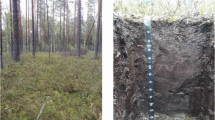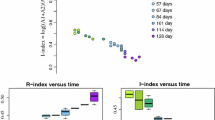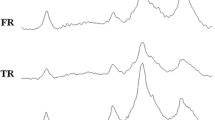Abstract
Purpose
Pyrogenic organic matter (PyOM) in the soil of a maritime pine forest in Central Italy, formed during a fire of high severity, was characterised by Fourier transform infrared (FT-IR) and 13C nuclear magnetic resonance (NMR). Furthermore, soil samples from burnt and unburnt sampling sites and natural charcoal collected from the ground were characterised after progressive heating under air and nitrogen atmosphere. The aim was to better understand the role fire plays on PyOM formation and oxidation.
Materials and methods
The top 10 cm of mineral soil and the above-lying charcoal particles were collected soon after the fire. Sampling was also performed on an adjacent unburnt portion of the forest. The bulk soil organic matter (SOM), its extractable fraction and charcoal particles were investigated by FT-IR and 13C NMR spectroscopies. They also underwent thermogravimetric analysis under air or N2, stop** the thermal reactions at the end of the first exothermic reaction in the range 350–500 °C.
Results and discussion
The NMR investigation clearly revealed a significant enrichment in aromatic and alkyl C in the burnt soil compared to the unburnt one. Several clues led to hypothesise that SOM was not exposed to extreme heating during the fire, notwithstanding the high fire severity estimated by a vegetation-based visual scale. In the thermal treatment mimicking fire, charcoal lost much of its mass and carbon content. However, at 500 °C, it still maintained a significant recalcitrant fraction. Nitrogen concentration in the bulk soil increased after heating, particularly under air condition. This phenomenon could be due to the formation of heterocyclic nitrogen compounds in the charred material.
Conclusions
In the study area, PyOM is rich in aliphatic compounds presumably because of the understory sclerophyllous vegetation typically found in Mediterranean environments. A large fraction of the charcoal released to the soil during the fire is sensitive to oxidation by subsequent fires. On the other hand, charcoal preserves a significant fraction of C, the most recalcitrant one, with expected long residence time in soil. PyOM formed under high oxygen availability is richer in N than that formed in inert atmosphere, which might make PyOM more susceptible to biochemical degradation.







Similar content being viewed by others
References
Almendros G, Knicker H, González-Vila FJ (2003) Rearrangement of carbon and nitrogen forms in peat after progressive thermal oxidation as determined by solid-state 13C- and 15N-NMR spectroscopy. Org Geochem 34:1559–1568
Almendros G, Martin F, González-Vila FJ (1988) Effects of fire on humic and lipid fractions in a Dystric Xerochrept in Spain. Geoderma 42:115–127
Benzing-Purdie L, Ripmeester JA, Preston CM (1983) Elucidation of the nitrogen forms in melanoidins and humic acid by nitrogen-15 cross polarization-magic angle spinning nuclear magnetic resonance spectroscopy. J Agr Food Chem 31:913–915
Certini G (2014) Fire as a soil-forming factor. Ambio 43:191–195
Certini G, Nocentini C, Knicker H, Arfaioli P, Rumpel C (2011) Wildfire effects on soil organic matter quantity and quality in two fire-prone Mediterranean pine forests. Geoderma 167:148–155
Dai KH, Johnson CE (1999) Applicability of solid-state 13C CP/MAS NMR analysis in Spodosols: chemical removal of magnetic materials. Geoderma 93:289–310
DeBano LF (2000) The role of fire and soil heating on water repellency in wildland environments: a review. J Hydrol 231–232:195–206
De la Rosa JM, González-Pérez JA, González-Vázquez R, Knicker H, López-Capel E, Manning DAC, González-Vila FJ (2008) Use of pyrolysis/GC–MS combined with thermal analysis to monitor C and N changes in soil organic matter from a Mediterranean fire affected forest. Catena 74:296–303
Doerr SH, Shakesby RA, Walsh RPD (2000) Soil water repellence: its causes, characteristics and hydro-geomorphological significance. Earth-Sci Rev 51:33–65
El-Hendawy ANA (2006) Variation in the FTIR spectra of a biomass under impregnation, carbonization and oxidation conditions. J Anal Appl Pyrol 75:159–166
Francioso O, Montecchio D, Gioacchini P, Cavani L, Ciavatta C, Trubetskoj O, Trubetskaya O (2009) Structural differences of Chernozem soil humic acids SEC-PAGE fractions revealed by thermal (TG-DTA) and spectroscopic (DRIFT) analyses. Geoderma 152:264–268
Francioso O, Sanchez-Cortes S, Bonora S, Roldán ML, Certini G (2011) Structural characterization of charcoal size-fractions from a burnt Pinus pinea forest by FT-IR, Raman and surface-enhanced Raman spectroscopies. J Mol Struct 994:155–162
Fuente E, Menendez JA, Diez MA, Suarez D, Montes-Moran MA (2003) Infrared spectroscopy of carbon materials: a quantum chemical study of model compounds. J Phys Chem B 107:6350–6359
González-Pérez JA, González-Vila FJ, Almendros G, Knicker H (2004) The effect of fire on soil organic matter—a review. Environ Int 30:855–870
Knicker H (2007) How does fire affect the nature and stability of soil organic nitrogen and carbon? A review. Biogeochemistry 85:91–118
Knicker H (2010) “Black nitrogen”—an important fraction in determining the recalcitrance of charcoal. Org Geochem 41:947–950
Knicker H (2011) Pyrogenic organic matter in soil: its origin and occurrence, its chemistry and survival in soil environments. Quatern Int 243:251–263
Knicker H, Almendros G, González-Vila FJ, González-Pérez JA, Polvillo O (2006) Characteristic alterations of quantity and quality of soil organic matter caused by forest fires in continental Mediterranean ecosystems: a solid-state 13C NMR study. Eur J Soil Sci 57:558–569
Knicker H, González-Vila FJ, Polvillo O, González JA, Almendros G (2005a) Fire-induced transformation of C- and N- forms in different organic soil fractions from a Dystric Cambisol under a Mediterranean pine forest (Pinus pinaster). Soil Biol Biochem 37:701–718
Knicker H, Hilscher A, Gonzàlez-Vila F, Almendros G (2008) A new conceptual model for the structural properties of char produced during vegetation fires. Org Geochem 39:935–939
Knicker H, Totsche KU, Almendros G, González-Vila FJ (2005b) Condensation degree of burnt peat and plant residues and the reliability of solid-state VACP MAS 13C NMR spectra obtained from pyrogenic humic material. Org Geochem 36:1359–1377
IUSS Working Group WRB (2014) World Reference Base for Soil Resources 2014. International soil classification system for naming soils and creating legends for soil maps. World Soil Resources Reports No. 106. FAO, Rome
Lozano E, Jiménez-Pinilla P, Mataix-Solera J, Arcenegui V, Bárcenas GM, González-Pérez JA, García-Orenes F, Torres MP, Mataix-Beneyto J (2013) Biological and chemical factors controlling the patchy distribution of soil water repellency among plant species in a Mediterranean semiarid forest. Geoderma 207–208:212–220
Mastrolonardo G, Certini G, Krebs R, Forte C, Egli M (2013) Effects of fire on soil organic matter quality along an altitudinal sequence on Mt. Etna, Sicily. Catena 110:133–145
Mastrolonardo G, Francioso O, Di Foggia M, Bonora S, Rumpel C, Certini G (2014) Application of thermal and spectroscopic techniques to assess fire-induced changes to soil organic matter in a Mediterranean forest. J Geochem Explor 143:174–182
McKissock I, Gilkes RJ, van Bronswijk W (2003) The relationship of soil water repellency to aliphatic C and kaolin measured using DRIFT. Aust J Soil Res 41:251–265
Moriondo M, Good P, Durao R, Bindi M, Giannakopoulos C, Corte-Real J (2006) Potential impact of climate change on fire risk in the Mediterranean area. Clim Res 31:85–95
Nguyen BT, Lehmann J, Hockaday WC, Joseph S, Masiello CA (2010) Temperature sensitivity of black carbon decomposition and oxidation. Environ Sci Technol 44:3324–3331
Nyquist RA (2001) Interpreting infrared, raman, and nuclear magnetic resonance spectra. Academic, San Diego
Nocentini C, Certini G, Knicker H, Francioso O, Rumpel C (2010) Nature and reactivity of charcoal produced and added to soil during wildfire are particle-size dependent. Org Geochem 41:682–689
Parson A, Robichaud PR, Lewis SA, Napper C, Clark JT (2010) Field guide for map** post-fire soil burn severity. Gen Tech Rep RMRS-GTR-243. US Dept of Agriculture, Forest Service, Rocky Mountain Research Station. Fort Collins, CO
Pausas JG, Llovet J, Rodrigo A, Vallejo R (2008) Are wildfires a disaster in the Mediterranean basin?—A review. Int J Wildland Fire 17:713–723
Pituello C, Francioso O, Simonetti G, Pisi A, Torreggiani A, Berti A, Morari F (2014) Characterization of chemical-physical, structural and morphological properties of biochars from biowastes produced at different temperatures. J Soil Sediments. doi:10.1007/s11368-014-0964-7 (this issue)
Preston CM, Newman RH (1995) A long-term effect of N fertilization on the 13C CPMAS NMR of de-ashed soil humin in a second-growth Douglas-fir stand of coastal British Columbia. Geoderma 68:229–241
Quideau S, Chadwick O, Benesi A, Graham R, Anderson M (2001) A direct link between forest vegetation type and soil organic matter composition. Geoderma 104:41–60
Rao CNR (1963) Chemical applications of infrared spectroscopy. Academic, New York
Rumpel C, Rabia N, Derenne S, Quenea K, Eusterhues K, Kögel-Knabner I, Mariotti A (2006) Alteration of soil organic matter following treatment with hydrofluoric acid (HF). Org Geochem 37:1437–1451
Santin C, Knicker H, Fernandez S, Menendez-Duarte R, Alvarez M (2008) Wildfires influence on soil organic matter in an Atlantic mountainous region (NW of Spain). Catena 74:286–295
Schmidt MWI, Noack AG (2000) Black carbon in soils and sediments: analysis, distribution, implications, and current challenges. Global Biogeochem Cy 14:777–793
Shakesby RA (2011) Post-wildfire soil erosion in the Mediterranean: review and future research directions. Earth-Sci Rev 105:71–100
Skjemstad J, Clarke P, Taylor J, Oades J, Newman R (1994) The removal of magnetic materials from surface soils—a solid state 13C CP/MAS NMR study. Aust J Soil Res 32:1215–1229
Skjemstad JO, Clarke P, Taylor JA, Oades JM, McClure SG (1996) The chemistry and nature of protected carbon in soil. Aust J Soil Res 34:251–271
Stoffyn-Egli P, Potter TM, Leonard JD, Pocklington R (1997) The identification of black carbon particles with the analytical scanning electron microscope: methods and initial results. Sci Total Environ 198:211–223
Author information
Authors and Affiliations
Corresponding author
Additional information
Responsible editor: José M. De la Rosa
Rights and permissions
About this article
Cite this article
Mastrolonardo, G., Francioso, O., Di Foggia, M. et al. Soil pyrogenic organic matter characterisation by spectroscopic analysis: a study on combustion and pyrolysis residues. J Soils Sediments 15, 769–780 (2015). https://doi.org/10.1007/s11368-014-1034-x
Received:
Accepted:
Published:
Issue Date:
DOI: https://doi.org/10.1007/s11368-014-1034-x




